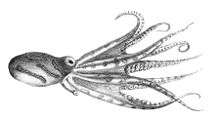Blue-lined octopus
The blue-lined octopus (Hapalochlaena fasciata) is one of three (or perhaps four) species of highly venomous blue-ringed octopuses. It is most commonly found around intertidal rocky shores and coastal waters to a depth of 15 metres (49 ft) between southern Queensland and southern New South Wales. It is relatively small, with a mantle up to 45 millimetres (1.8 in) in length. In its relaxed state, it is a mottled yellow-brown with dark blue or black streaks covering the whole body apart from the underside of its arms, but its vibrant blue patches appear as a warning when they feel threatened. Along with its other closely related species, the blue-lined octopus is regarded as one of the most dangerous animals in the sea, and its venom can be fatal to humans. The blue-lined octopus’s saliva contain a special neurotoxin called tetrodotoxin which causes muscle weakness and respiratory failure. It’s so lethal that it’s been estimated that the venom from a single 25 gram octopus can kill about 75 humans.[1] It is one of the most common of several species of blue-ringed octopuses found in Sydney. Their size range from 4.5 cm, of an adult, to 5.5 cm.[2]
| Blue-lined octopus | |
|---|---|
 | |
| Hapalochlaena fasciata | |
| Scientific classification | |
| Kingdom: | Animalia |
| Phylum: | Mollusca |
| Class: | Cephalopoda |
| Order: | Octopoda |
| Family: | Octopodidae |
| Genus: | Hapalochlaena Robson, 1929 |
| Species: | H. fasciata |
| Binomial name | |
| Hapalochlaena fasciata (Hoyle, 1886) | |
References
- Townsend, Kathy A.; Altvater, Jens; Thomas, Michael C.; Schuyler, Qamar A.; Nette, Geoffrey W. (March 2012). "Death in the octopus' garden: fatal blue-lined octopus envenomations of adult green sea turtles". Marine Biology. 159 (3): 689–695. doi:10.1007/s00227-011-1846-9. ISSN 0025-3162. PMC 3873062. PMID 24391271.
- "Blue-lined Octopus - Australian Museum". Retrieved 30 May 2016.
External links
- "CephBase: Blue-lined octopus". Archived from the original on 2005.
- Life In The Fast Lane-Toxicology Conundrum #011